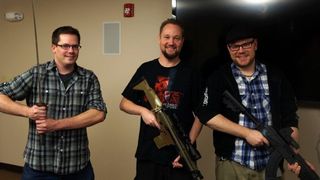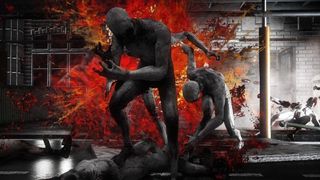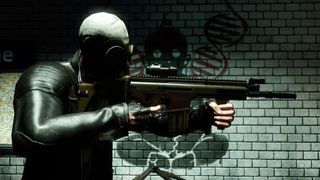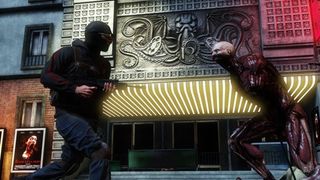Killing Floor 2: How Tripwire aims to design gaming's most realistic guns

Pictured above: Tripwire's David Hensley, John Gibson and Bill Munk holding weapons that appear in Killing Floor 2.
Tripwire Entertainment knows a thing or two about guns—both the real deal, and the ones they create in video games like the upcoming Killing Floor 2 . In 2006, as a mod-team-turned-development studio working on World War 2 shooter Red Orchestra , they managed to create reload animations smoother and more detailed than the large teams developing Battlefield and Call of Duty.
"[Back then] we heard 'how come these guys' reload animations are better than yours?'" says Tripwire's president, John Gibson, thinking back to the competitive World War 2 market in 2006. "We heard the same thing about our sounds. We had pretty good sounds in the first Red Orchestra game. And the DICE guys actually said that motivated them to want to do better, and that's why Battlefield Bad Company had such amazing sounds. They were like 'crap, we have to do better than these guys.'"
For Red Orchestra and Red Orchestra 2 , Tripwire earned a reputation for authenticity. With Killing Floor , Tripwire's wave-based co-op shooter released in 2009, fans started calling Tripwire's digital firearms “gun porn.” Killing Floor players praised how fun the guns were to fire and how detailed and different each firearm was. Killing Floor also let Tripwire get weird, with completely fictional weapons like the Zed Eradication Device.
Now Tripwire is developing Killing Floor 2 with eyes on an Early Access release for SteamOS and Windows. The crazy mutant freak hordes of Killing Floor and its sci-fi trappings don't mean Tripwire is giving up on accurately rendering real-world weapons, though. Gibson just wants every single gun to be cooler than ever.
Animated fire
Before making Red Orchestra 2, Tripwire's developers fired dozens of guns to record audio of each weapon and study how it performed. They used their study session to create more accurate recoil for machine guns. Killing Floor 2's larger budget means the team can go one step further: full motion capture for insanely high framerate reload animations.
"Guns shoot at such a high framerate, if you animated the gun at 30 frames per second, you're only going to get six frames per second when you go into slow-mo in detail to show that gun animating," says lead animator Bill Munk. At 30 fps, most gun animations just show a "generic forward and back motion." For KF2, Tripwire committed to higher framerate animations that would preserve the details of firing and reloading even in Zed Time, the slow-mo system that kicks in when cool things happen in Killing Floor.
The biggest gaming news, reviews and hardware deals
Keep up to date with the most important stories and the best deals, as picked by the PC Gamer team.

"Using the Bullpup as an example, we animated at 242 frames per second, which gives us 22 frames per shell that ejects out of the weapons," Munk tells me. "The weapon shoots at 660 rounds per minute, which equals 11 rounds per second. In slow-mo you can actually see every kickback. In realtime you can't see these details but it makes the guns feel more powerful. We've come up with a formula to calculate: we have a weapon, this is its rate of fire—how many frames to do want to have per actual kickback, to make sure the fidelity of it is absolutely perfect? To my knowledge, no game is doing something like that, or would even think it would be worth doing something like that."
Gibson breaks it down. "At this rate of fire, you'd have one frame of animation to shoot. To put that in perspective, if you've ever done one of those little flipbook animation things, a frame is essentially one page. So you'd have one page to represent the barrel wiggling, the shell ejecting, the bolt moving back. It's a small touch, but it adds to the feel of it really happening."
Gibson gets even more excited about KF2's new gun technology when he talks about weapon accuracy and recoil. Most games, he explains, represent accuracy with a bullet spread. Less accurate guns will have a wider spread on their bullets, so planting your crosshair dead center on a target doesn't guarantee a hit. "We wanted to actually have the gun physically move instead of having some magic number that you tweak that makes the bullets go in random directions. The gun's accurate; if you can manage to keep your sights on an enemy, you will hit it. The crosshair's just moving around, but wherever that crosshair is, that's where the bullet's actually going."
For the motion captured weapon reloads in KF2, Tripwire researched speed reloads on Youtube , watching and imitating the reload tricks of modern gunslingers. Each gun in the game has four different reload animations: two regular and two faster "elite" reloads, based on whether a magazine is partially full or empty. The elite reloads are locked behind perk abilities: you'll have to earn them.

There's a noticeable difference in speed between the regular reloads and elite reloads with rifles like the Bullpup, which will be a lifesaver in tough Killing Floor 2 matches. Munk promises that other weapons will have reloads that are as ridiculous and badass as they are useful.
Tripwire motion captured every reload to create third person animations. But Killing Floor is a first-person shooter. Munk is proud when he talks about how they used the motion capture recordings.
"The raw mocap data just gets authored two separate ways to create the third- and first-person [animations]," he says. "Creating third [person] is actually way easier. If a guy's moving and shifting his weight, it's great, but in first person it's really weird...it feels really awkward and stiff. That's one reason why Arma feels really awkward. In third-person they're using the first person animations, so it doesn't feel like it's been specifically edited for that. We've massaged it so it's perfect for what we're doing."
Weapon balance
Despite Killing Floor 2's over-the-top sci-fi tone, Tripwire still aims to keep its weapons fairly true to life. The designers match rate of fire with real guns and have gone out of their way to correct some lingering inaccuracies from the first Killing Floor and its progenitor, an Unreal Tournament 2004 mod. In KF1, a round from the 9mm pistol actually dealt more damage than a bullet from the Bullpup rifle. That's not true in KF2.
Weapons are also being balanced more carefully. Each perk has four primary weapons, ranked weakest to strongest, and no future DLC weapons will change that tier system. The most powerful assault rifle will stay the most powerful assault rifle, but "sidegrades" will offer more options—higher rate of fire but lower damage, higher stun or knockback against the Zeds. Damage values aren't rigorously beholden to the real-world weapons.
"With RO2, the model is, make it just like real life," Gibson says. "The recoil, the way the gun moves when you shoot, the accuracy of the weapon, the damage of the weapon. For the most part we model reality."
Gibson explains that Red Orchestra's balance comes from controlling access to weapons. "Some games have unlimited snipers! Not in RO2. There are a couple snipers on a team, a couple machine guns, and we try to take a realistic format that was fairly balanced in the real world and apply it to the game. What we've always said about the RO franchise is we take the fun parts of realism. It is not fun to be cowering in a trench getting artillery dropped on you for hours on end and crapping your pants. But it is fun to line up a shot on a distant target while your guy's breathing and you finally nail that long distance shot and you know that it was challenging and rewarding to do."

With four weapon tiers spread across a planned 10 perks, plus backups like pistols and melee weapons, balancing Killing Floor 2's entire arsenal will be a big job. So far, Tripwire isn't talking about most of the game's arsenal. The SCAR 17, AK-12, Bullpup, and 9mm AR-15 are Commando weapons already implemented in the game. The Mossberg 500 shotgun will also make an appearance.
Tripwire knows how to nail the feel of KF2's weapons, but perfect balance can only come from large scale playtesting. Enter Early Access and the Killing Floor community.
"It's about getting the players' feedback and letting that inform us to make smart decisions for what becomes the full release," Gibson says. "We're excited to get it into peoples' hands. We don't want to wait...we want to see their reaction, get their feedback. That's a big driver to do Early Access."
Tripwire won't say when Killing Floor 2 is coming, but its weapons may set a new bar for FPS fidelity. If, in a couple years, you're playing the next Battlefield and notice that the reload animations are especially detailed, you'll know who DICE was hellbent on beating.
For more on Killing Floor 2, make sure to read our exclusive reveal feature .

Wes has been covering games and hardware for more than 10 years, first at tech sites like The Wirecutter and Tested before joining the PC Gamer team in 2014. Wes plays a little bit of everything, but he'll always jump at the chance to cover emulation and Japanese games.
When he's not obsessively optimizing and re-optimizing a tangle of conveyor belts in Satisfactory (it's really becoming a problem), he's probably playing a 20-year-old Final Fantasy or some opaque ASCII roguelike. With a focus on writing and editing features, he seeks out personal stories and in-depth histories from the corners of PC gaming and its niche communities. 50% pizza by volume (deep dish, to be specific).
Most Popular






